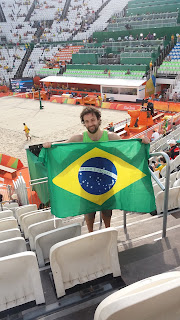Moro no Brasil há mais de um ano. Desde que cheguei, algumas pessoas me perguntam sobre meus pensamentos sobre o Brasil. Elas me perguntam por que eu moro aqui e se eu gosto daqui.
Existem muitas razões por que eu gosto do Brasil. Aqui é uma lista do top 10.
1) Esta É A Casa Da Minha Esposa
A primeira razão de eu gostar de viver no Brasil é que esta é a casa da minha esposa. Ela é a razão por eu estar aqui. Apesar das outras coisas na lista, sem Ela, eu não estaria aqui. Vivendo em sua cidade e conhecendo seus amigos, sua família e sua cultura tem sido uma experiência incrível. E é uma experiência que eu não mudaria.2) Há Muita Comida Boa
Se você está com fome, Brasil é o primeiro lugar para ficar. Há muitos restaurantes que servem buffet livre.A melhor opção é o churrasco. Enquanto todo mundo sabe como os brasileiros fazem um churrasco delicioso, os brasileiros sabem que o melhor churrasco é feito por Gaúchos aqui no Rio Grande do Sul.
Enquanto a variedade de comida não é a melhor aqui no Brasil, tem alguns restaurantes que oferecem comida do Peru, da Espanha e mesmo da Austrália.
3) Cervejas Artesanais
Em geral, não acho que o Brasil tem cervejas boas. A maior parte das opções são quase“imbebíveis”.
Apesar disso, aqui em Porto Alegre, tem muitas cervejarias pequenas que fazem algumas cervejas muito boas. Parece que tem um festival de cerveja todos os meses e há também muitos bares que vendem de cervejarias locais. Significa que você pode beber cerveja boa onde quer que você vá. As Cervejarias pequenas podem ser caras, mas eu prefiro beber cervejas de boa qualidade sempre. Cervejarias locais como Perro Libre, Baldhead, Zapata, Irmãos Ferraro, Seasons e Elementum sáo as que valem a pena o dinheiro. A vida é curta demais para beber cerveja ruim. Alguns bares e restaurantes que servem cerveja boa são Penz Bier, Dirty Old Man, Bier Markt, Locals Only, Hooroo House, A Virgem, Heilige Brew Pub e Lagom.
4) Brasileiros São Muito Amigáveis
Quase todas as pessoas que eu conheci desde que eu cheguei no Brasil foram muito acolhedoras e amigáveis. Quando eu estava no Rio para os Jogos Olímpicos, uma multidão de pessoas me aplaudiu porque eu sou australiano e então aplaudiram a minha esposa porque ela se casou com um australiano.Onde quer que eu vá no Brasil, as pessoas parecem interessadas em aprender mais sobre mim e me fazer sentir bem-vindo. Eles querem me ensinar sobre comidas locais como churrasco e eventos culturais como Semana Farroupilha.
5) Os Brasileiros Adoram Compartilhar
Uma das melhores coisas sobre brasileiros é que eles adoram fazer coisas juntos. A maior partes das tradições deles são feitas em grupo e não como indivíduos ou casais. Quando você vai para um parque em Porto Alegre, você vê grupos de pessoas curtindo chimarrão ou fazendo um churrasco. Em uma festa eles estarão compartilhando um copo de caipirinha. Eles são pessoas muito sociais.6) Pode Beber Na Rua
Na maior parte da Austrália (e no mundo) não pode beber cerveja, vinho ou outras bebidas com álcool na rua ou em outros lugares públicos. É diferente aqui. No Brasil pode beber quase em qualquer lugar. A exceção é, estranhamente, em jogos de futebol.Isso torna a celebração muito mais fácil. Festas de rua não precisam se preocupar com regras de álcool. Significa que tem mais festas na rua. Há algumas pessoas que vendem cervejas em qualquer evento, então você não precisa ficar na fila para comprar cerveja cara de vendedores oficiais. Se você quer beber uma cerveja você pode, sem preocupações.






























